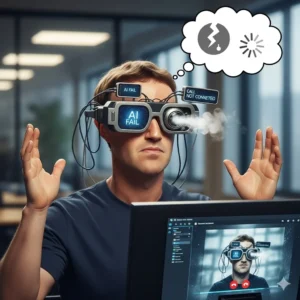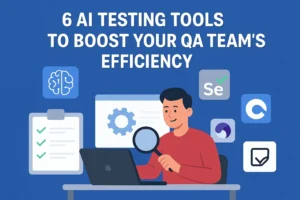Back-to-back meetings. Endless note-taking. Fuzzy memories. Sound familiar? You leave the room, and suddenly, what was that key decision? Who owned the follow-up? It’s gone. In today’s fast-moving business world, poor meeting documentation isn’t just frustrating; it’s expensive. Ideas fade, accountability slips, and momentum dies.
This is precisely why companies are leaning toward AI scribes, not as a nice-to-have but as a dire necessity. These tools do not simply capture meetings; instead, they freeze your team’s thinking, safeguard accountability, and liberate you to concentrate on progress, not falling behind.
Understanding the AI Scribe Revolution in Business Communication
Pen and paper are obsolete for note-taking. Memorizing or rewatching hours of footage hampers productivity and increases the possibility of error. AI Transcribers have revolutionized meeting documentation, moving from frantic scribbling on tablets to real-time, razor-sharp transcripts with context, nuance, and relevance.

These tools don’t merely transcribe words. They understand them, whether it’s identifying decisions made or pinpointing who committed to what. The Best AI scribe provides organized meeting records you can trust.
What Sets AI Scribes Apart from Traditional Transcription Methods
People, whether service-industry professionals or not, have always been the backbone of transcription, and that hasn’t necessarily come with a guarantee of accuracy. Humans forget things, zone out, or misunderstand the spoken word. Even if recordings are used, it requires someone to go back and manually listen, transcribing for hours.
AI-based transcription software solves both issues. They work in real time, identify multiple speakers , and learn industry-specific terminology. This precision renders AI tools actionable in complex environments with multiple speakers or participants that manual note-taking cannot serve. These intelligent systems differentiate between participants, understand the tone, and apply structure to transcripts in a way that makes it intuitive and effortless to search.
The Core Technology Behind Modern AI Transcription Services
Natural Language Processing (NLP) is at the core of the best Artificial intelligence transcription tool. This technology allows the system to assess not only vocabulary but intent as well as context. With each million or so examples of actual conversations, algorithms are improving performance.
Such systems recognize speakers, detect action items, and structure output to match the flow of a meeting. It automatically tags it with the mention of a follow-up task. The result? A record that is clean, searchable, and actionable.
AI Scribes Deliver 7 Critical Benefits for Businesses
Enhanced Accuracy Through Contextual Understanding
What makes a Real-time transcription software stand out is its ability to understand not just speech but meaning. In fields with technical jargon or nuanced language, that understanding is crucial. Whether it’s recognizing “CMS” as a healthcare regulation or spotting industry-specific terms in finance or engineering, AI Transcribers are smart enough to adapt. They also accommodate a variety of accents and speech styles, making them ideal for diverse, global teams.

Time and Resource Optimization
Manual transcription takes time. Multiply that by the number of meetings held each month, and the cost becomes clear. It significantly reduce the time spent on documenting meetings, freeing up teams to focus on core tasks.
That translates directly to improved productivity and lower costs. Instead of hiring transcriptionists or losing hours to note-taking, businesses can automate this task and redeploy resources.
Accessibility and Inclusivity Improvements
For teams with hearing-impaired members or those working across multiple languages, AI Transcribers level the playing field. Live transcription enables everyone to follow along, while searchable text ensures no one misses out due to a language barrier or auditory challenge. Supporting multiple languages and formats, these tools make global collaboration simpler, more inclusive, and more efficient.
Searchable Knowledge Repositories
Meeting transcription solution turns once-ephemeral discussions into lasting institutional knowledge. With transcripts stored and categorized, team members can search past meetings, retrieve crucial context, and avoid redundant conversations.

This isn’t just about saving time. It’s about building a searchable brain for your business, one that remembers what your team decides, discusses, and defers.
Choosing the Right AI Transcription Tool for Your Business
Not all transcription tools are created equal. To ensure your chosen solution fits your workflow, consider these key factors:
- Accuracy in your specific industry
- Integration with platforms like Zoom, Slack, or Microsoft Teams
- Security and compliance capabilities
- Customization options for unique terminology
- Transparent pricing and ROI clarity
The right tool doesn’t just capture meetings, it complements your business infrastructure.
Implementation Strategies for Maximum Transcription Accuracy
Optimizing Your Meeting Environment
To get the most out of your AI Transcribers, start with the basics:
- Position high-quality microphones centrally
- Reduce ambient noise
- Ask participants to speak clearly and take turns
- Brief attendees on the transcription process
These small changes can make a big difference in transcription clarity.
Training Your AI Scribe for Peak Performance
Most top-tier Artificial intelligence transcription tools allow users to create custom vocabularies. That means you can teach your AI meeting assistant industry-specific terms, product names, or company acronyms.
Spending a little time upfront on training results in transcripts that are more relevant and accurate in the long term. Your Artificial intelligence transcription tool becomes more than just a tool; it becomes a knowledge asset tailored to your business.
AI Scribe vs Traditional Methods
| Feature | Traditional Transcription | AI Scribe Solution |
| Turnaround Time | Hours to Days | Real-Time or Minutes |
| Accuracy with Jargon | Inconsistent | High, with Custom Vocabulary |
| Cost Efficiency | High Labor Costs | Lower, One-Time or Subscription |
| Speaker Identification | Manual Effort | Automatic |
| Searchable Archives | Limited, Unstructured | Fully Searchable and Organized |
| Accessibility Features | Requires Manual Subtitles | Built-In Live Transcripts |
| Integration Capabilities | Manual Export Required | Seamless Platform Integration |
Why AI Adoption Isn’t Limited to Meetings
The transformative impact of AI doesn’t end with transcriptions. It extends into areas like data analysis, customer service, and even AI for stock trading, where algorithms sift through massive datasets to make informed decisions in real time. This broad utility shows that AI isn’t a temporary trend. It’s an operational shift, and transcription is one of the first and most effective steps toward embracing its potential.
Conclusion
With an AI meeting assistant in place, meetings stop being memory tests and start becoming action-oriented sessions with clear takeaways. Organizations that prioritize accurate, real-time transcription don’t just work smarter, they build a culture of accountability, clarity, and progress.
The best transcription tool serves as a bridge between conversation and execution, ensuring every voice is heard, every decision is documented, and no detail falls through the cracks.
Frequently Asked Questions
1. How accurate are AI scribes compared to human transcriptionists?
The best Artificial intelligence transcription services now match or exceed the accuracy of human transcribers under good audio conditions. They handle multiple speakers and technical language effectively while delivering results instantly and at a lower cost.
2. What features should I prioritize when choosing an AI transcription service?
Look for strong accuracy in your industry, seamless integration with tools you already use, customizable vocabulary features, and a solid track record for security. A flexible pricing model helps, too.
3. Can AI transcription tools handle technical terminology and industry jargon?
Yes, especially when you leverage tools that support custom vocabulary training. With a bit of initial input, these systems learn to recognize and accurately transcribe your specific terminology.












